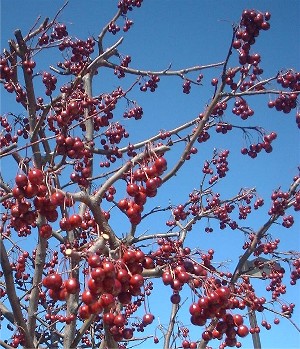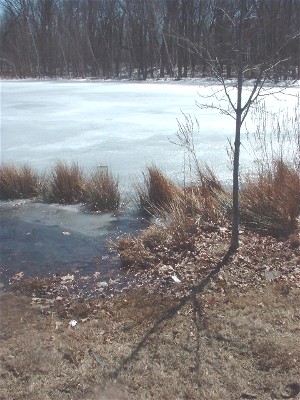As I was posting the reference below to Stravinsky’s Rite of Spring, unbeknown to me, my mother was unearthing photographs of my daughter who, as a junior in high school, choreographed, costumed, and danced her own original interpretation of that piece. Her costume was flesh-colored and glittery. Her makeup dramatic. Her movements fierce. This in a school district community that, at the time, was quite unsophisticated. (Actually, given the large number of current unsophisticated national constituencies, it was apparently ahead of its time.)
Anway, I just love this photo, which, according to writing on the back, was taken and given to her by one of my daughter’s teachers.

I must not have taken any photos of her that evening since no others are turning up. I do remember sitting in the middle of the audience listening to the murmurs during her performance that probably had more to do with the fact that she wasn’t wearing a bra under her leotard than with the choice of performance piece. I wish I could have taped the comments afterward from other parents as they tried to come up with something that would not give away their real opinions.
Daily Archives: March 26, 2005
singing to spring
to stroke the skin of ripening
birches fringed like armies
of buckskinned arms, their fine-boned
fingers splattering buds like spots
of blood in the sky
The above is from one of my poems that was published back in the mid-eighties. The birches in the park haven’t yet begun to sprout, but there are these bushes doing something similar:

My favorite spring poem is this one by ee cummings (sorry, but the spacing doesn’t seem to come out the way it’s supposed to, even though it looks fine in the “entry” box).
in just-
in Just-
spring when the world is mud-
luscious the little
lame balloonman
whistles far and wee
and eddieandbill come
running from marbles and
piracies and it’s
spring
when the world is puddle-wonderful
the queer
old balloonman whistles
far and wee
and bettyandisbel come dancing
from hop-scotch and jump-rope and
it’s
spring
and
the
goat-footed
balloonman whistles
far
and
wee
Around here it is certainly JUST spring. The ice is just thinning. The mud is just emerging into something puddleluscious. The sky today is an Easter Bunny blue, but just how long it will last is anybody’s guess.

I have always done whatever spring cleaning I get around to doing with Stravinsky’s Rite of Spring blaring in the background.
It’s time for revving up. C’mon Oestre. You go, girl.
Take that, you simplistic scientists!
A little early for April Fool’s Day, but this — from Scientific American via Too Much and Too Little — is too good to make wait.
from the Scientific American editorial
Okay, We Give Up
There’s no easy way to admit this. For years, helpful letter writers told us to stick to science. They pointed out that science and politics don’t mix. They said we should be more balanced in our presentation of such issues as creationism, missile defense and global warming. We resisted their advice and pretended not to be stung by the accusations that the magazine should be renamed Unscientific American, or Scientific Unamerican, or even Unscientific Unamerican. But spring is in the air, and all of nature is turning over a new leaf, so there’s no better time to say: you were right, and we were wrong.
In retrospect, this magazine’s coverage of so-called evolution has been hideously one-sided. For decades, we published articles in every issue that endorsed the ideas of Charles Darwin and his cronies. True, the theory of common descent through natural selection has been called the unifying concept for all of biology and one of the greatest scientific ideas of all time, but that was no excuse to be fanatics about it.
Where were the answering articles presenting the powerful case for scientific creationism? Why were we so unwilling to suggest that dinosaurs lived 6,000 years ago or that a cataclysmic flood carved the Grand Canyon? Blame the scientists. They dazzled us with their fancy fossils, their radiocarbon dating and their tens of thousands of peer-reviewed journal articles. As editors, we had no business being persuaded by mountains of evidence.
Moreover, we shamefully mistreated the Intelligent Design (ID) theorists by lumping them in with creationists. Creationists believe that God designed all life, and that’s a somewhat religious idea. But ID theorists think that at unspecified times some unnamed superpowerful entity designed life, or maybe just some species, or maybe just some of the stuff in cells. That’s what makes ID a superior scientific theory: it doesn’t get bogged down in details.
Good journalism values balance above all else. We owe it to our readers to present everybody’s ideas equally and not to ignore or discredit theories simply because they lack scientifically credible arguments or facts. Nor should we succumb to the easy mistake of thinking that scientists understand their fields better than, say, U.S. senators or best-selling novelists do. Indeed, if politicians or special-interest groups say things that seem untrue or misleading, our duty as journalists is to quote them without comment or contradiction. To do otherwise would be elitist and therefore wrong. In that spirit, we will end the practice of expressing our own views in this space: an editorial page is no place for opinions.
Get ready for a new Scientific American. No more discussions of how science should inform policy. If the government commits blindly to building an anti-ICBM defense system that can’t work as promised, that will waste tens of billions of taxpayers’ dollars and imperil national security, you won’t hear about it from us. If studies suggest that the administration’s antipollution measures would actually increase the dangerous particulates that people breathe during the next two decades, that’s not our concern. No more discussions of how policies affect science either ”so what if the budget for the National Science Foundation is slashed? This magazine will be dedicated purely to science, fair and balanced science, and not just the science that scientists say is science. And it will start on April Fools’ Day.
Okay, We Give Up
MATT COLLINS
THE EDITORS editors@sciam.com
COPYRIGHT 2005 SCIENTIFIC AMERICAN, INC.
